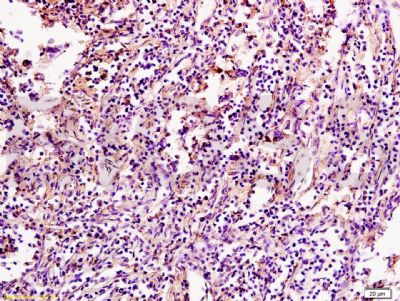
APOA1,载脂蛋白A1抗体
产品名称: APOA1,载脂蛋白A1抗体
英文名称: Anti-APOA1 antibody
产品编号: HZ-0849R
产品价格: null
产品产地: 中国/美国
品牌商标: HZbscience
更新时间: 2023-08-17T10:24:20
使用范围: WB,ELISA,IHC-P,IHC-F,IF
- 联系人 : 鲍丽雯
- 地址 : 上海市闵行区闵北路88弄1-30号第22幢AQ136室
- 邮编 : 200612
- 所在区域 : 上海
- 电话 : 139****0749 点击查看
- 传真 : 点击查看
- 邮箱 : www.shzbio.net
- 二维码 : 点击查看
APOA1,载脂蛋白A1抗体
产品编号HZ-0849R
英文名称APOA1
中文名称载脂蛋白A1抗体
别 名AI BP; AIBP; ApoA I binding protein; Apolipoprotein A I; Apolipoprotein A 1; Apo AI; ApoA I; APOA1; APOA1/APOC3 fusion gene; Apo A1; Apo-A1; Apolipoprotein A I precursor; Apolipoprotein A I binding protein; Apolipoprotein AI; Apolipoprotein of high density lipoprotein; ApolipoproteinAI; Brp14; Ltw1; Lvtw1; MGC117399; MGC119143; MGC119144; MGC119145; NAD(P)H hydrate epimerase; NAD(P)HX epimerase; YjeF N terminal domain containing protein 1; yjeF_N1; YJEFN1; APOA1_HUMAN; Sep1; Sep2.
规格价格0.1ml 0.2ml
说 明 书0.1ml 0.2ml
研究领域心血管 免疫学 糖尿病
APOA1,载脂蛋白A1抗体抗体来源Rabbit
克隆类型Polyclonal
交叉反应Human, Mouse, Chicken, Pig, Cow,
产品应用WB=1:100-500 ELISA=1:500-1000 IHC-P=1:100-500 IHC-F=1:100-500 IF=1:100-500 (石蜡切片需做抗原修复)
not yet tested in other applications.
optimal dilutions/concentrations should be determined by the end user.
分 子 量28kDa
细胞定位分泌型蛋白
性 状Lyophilized or Liquid
浓 度1mg/1ml
免 疫 原KLH conjugated synthetic peptide derived from human APOA1
亚 型IgG
纯化方法affinity purified by Protein A
储 存 液0.01M TBS(pH7.4) with 1% BSA, 0.03% Proclin300 and 50% Glycerol.
保存条件Store at -20 °C for one year. Avoid repeated freeze/thaw cycles. The lyophilized antibody is stable at room temperature for at least one month and for greater than a year when kept at -20°C. When reconstituted in sterile pH 7.4 0.01M PBS or diluent of antibody the antibody is stable for at least two weeks at 2-4 °C.
APOA1,载脂蛋白A1抗体PubMedPubMed
产品介绍background:
This gene encodes apolipoprotein A-I, which is the major protein component of high density lipoprotein (HDL) in plasma. The protein promotes cholesterol efflux from tissues to the liver for excretion, and it is a cofactor for lecithin cholesterolacyltransferase (LCAT) which is responsible for the formation of most plasma cholesteryl esters. This gene is closely linked with two other apolipoprotein genes on chromosome 11. Defects in this gene are associated with HDL deficiencies, including Tangier disease, and with systemic non-neuropathic amyloidosis. [provided by RefSeq, Jul 2008]
Function:
Participates in the reverse transport of cholesterol from tissues to the liver for excretion by promoting cholesterol efflux from tissues and by acting as a cofactor for the lecithin cholesterol acyltransferase (LCAT). As part of the SPAP complex, activates spermatozoa motility.
Subunit:
Interacts with APOA1BP and CLU. Component of a sperm activating protein complex (SPAP), consisting of APOA1, an immunoglobulin heavy chain, an immunoglobulin light chain and albumin. Interacts with NDRG1.
Subcellular Location:
Secreted.
Tissue Specificity:
Major protein of plasma HDL, also found in chylomicrons. Synthesized in the liver and small intestine. The oxidized form at Met-110 and Met-136 is increased in individuals with increased risk for coronary artery disease, such as in carrier of the eNOSa/b genotype and exposure to cigarette smoking. It is also present in increased levels in aortic lesions relative to native ApoA-I and increased levels are seen with increasing severity of disease.
APOA1,载脂蛋白A1抗体Post-translational modifications:
Palmitoylated.
Met-110 and Met-136 are oxidized to methionine sulfoxides.
Phosphorylation sites are present in the extracelllular medium.
DISEASE:
Defects in APOA1 are a cause of high density lipoprotein deficiency type 2 (HDLD2) [MIM:604091]; also known as familial hypoalphalipoproteinemia (FHA). Inheritance is autosomal dominant.
Defects in APOA1 are a cause of the low HDL levels observed in high density lipoprotein deficiency type 1 (HDLD1) [MIM:205400]; also known as analphalipoproteinemia or Tangier disease (TGD). HDLD1 is a recessive disorder characterized by the absence of plasma HDL, accumulation of cholesteryl esters, premature coronary artery disease, hepatosplenomegaly, recurrent peripheral neuropathy and progressive muscle wasting and weakness. In HDLD1 patients, ApoA-I fails to associate with HDL probably because of the faulty conversion of pro-ApoA-I molecules into mature chains, either due to a defect in the converting enzyme activity or a specific structural defect in Tangier ApoA-I.
Note=A mutation in APOA1 is the cause of amyloid polyneuropathy-nephropathy Iowa type (AMYLIOWA); also known as amyloidosis van Allen type or familial amyloid polyneuropathy type III. AMYLIOWA is a hereditary generalized amyloidosis due to deposition of amyloid mainly constituted by apolipoprotein A1. The clinical picture is dominated by neuropathy in the early stages of the disease and nephropathy late in the course. Death is due in most cases to renal amyloidosis. Severe peptic ulcer disease can occurr in some and hearing loss is frequent. Cataracts is present in several, but vitreous opacities are not observed.
Defects in APOA1 are a cause of amyloidosis type 8 (AMYL8) [MIM:105200]; also known as systemic non-neuropathic amyloidosis or Ostertag-type amyloidosis. AMYL8 is a hereditary generalized amyloidosis due to deposition of apolipoprotein A1, fibrinogen and lysozyme amyloids. Viscera are particularly affected. There is no involvement of the nervous system. Clinical features include renal amyloidosis resulting in nephrotic syndrome, arterial hypertension, hepatosplenomegaly, cholestasis, petechial skin rash.
Similarity:
Belongs to the apolipoprotein A1/A4/E family.
Gene ID:
335
Database links:
Entrez Gene: 335 Human
Omim: 107680 Human
SwissProt: P02647 Human
Unigene: 93194 Human
Important Note:
This product as supplied is intended for research use only, not for use in human, therapeutic or diagnostic applications.
APOA1是检测高密度脂蛋白的主要形式,APOA1降低被认为是心、脑血管疾病的危险因素。
APOA1升高:常见于肝脏疾病、肝外胆道阻塞、人工透析。
APOA1降低:常见于冠心病、未控制的糖尿病、肾病综合征、营养不良、活动性肝炎、肝功能低下、动脉粥样硬化、高脂蛋白血症。

